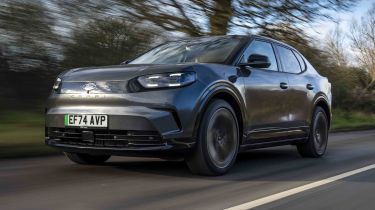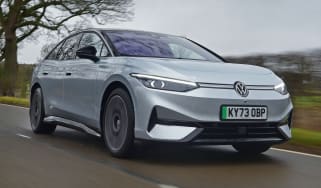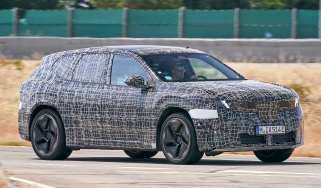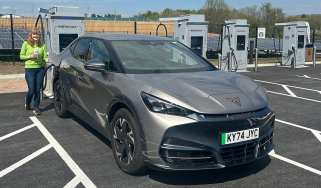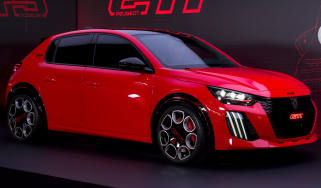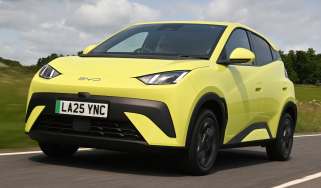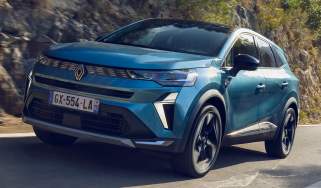Ford Capri review
It’s no sports car or retro reboot – rather a refined and well-built EV that happens to sport a controversial name

Is the Ford Capri a good car?
Lovers of the classic Ford Capri need not apply, but for everyone else, the latest Capri is a well executed mid-size electric SUV with a smart interior and impressive powertrains. There’s not much added substance over the closely related Ford Explorer, and it doesn’t offer a hugely engaging driving experience to go with the sporty styling. But if the Capri’s expressive exterior design floats your boat and you can stomach the high price tag, then there’s every reason to consider it.
| Key specs | |
| Fuel type | Electric |
| Body style | Mid-size SUV |
| Powertrain | 52kWh battery, 1x e-motor, rear-wheel drive 77kWh battery, 1x e-motor, rear-wheel drive 79kWh battery, 2x e-motors. four-wheel drive |
| Safety | 5 stars (Euro NCAP 2024) |
| Warranty | 3yrs/60,000 miles |
Say hello to one of the most contentious cars launched in recent history. We know the Ford Capri is one of the UK’s most loved nameplates, so to apply it to an electric SUV with little more than a passing resemblance to the original is an interesting move. But, if we consider the latest Capri as a stylish, family-friendly electric car, rather than a reborn icon of the ‘70s, it actually stacks up rather well.
Just as with the Ford Explorer, the Capri is a product of a technical partnership with Volkswagen and therefore shares its underpinnings with the VW Group’s all-electric MEB platform. This applies many of the elements that you can’t see, such as the electric powertrain and basic chassis, but the bits you can are convincingly different, whether that be the interior tech or exterior styling.
All versions come well-equipped, with the Style trim getting 19-inch alloy wheels, LED lights front and rear, and a movable 14.6-inch portrait touchscreen. Our preferred Mid-range Select trim adds heated front seats, an electrically adjustable driver’s seat with memory settings and a massage function, and wireless phone charging. The top-of-the-range Premium trim has larger 20-inch alloys, matrix-LED headlights, an electric tailgate with hands-free operation, a panoramic glass roof and an upgraded B&O sound system.
How much does the Ford Capri cost?
The Capri will launch with a combination of different battery and motor options, with prices starting at just under £41,500, putting it at the upper end of the price spectrum compared with key rivals. Beyond this are three trim levels: Style, Select and Premium, with a limited range of option packages available for each.
Used - available now

2025 Ford
Capri
AutomaticElectric
Cash £50,700The base price is for a 52kWh single-motor model, which we haven't gotten behind the wheel of yet because it wasn't available at launch, so we’re focusing on the 77kWh single-motor starting at around £48,000, and 79kWh dual-motor variants, costing over £56,000.
Electric motors, performance & drive
The good news is that VW’s technical toolkit is a fine one to draw from, as the various refinements that come with its recent upgrades start the Capri on the front foot. All versions have a good amount of power without feeling excessive, but it’s the torque that helps the Capri to feel effortless in a very satisfying, almost GT-like fashion.
Pin your foot to the floor, and there’s no rampant acceleration, rather a gentle surge that makes light work of the Capri’s near-2.1 tonne weight. The powertrain is also impressively refined, with no discernible motor whine and good throttle calibration. As with VW, Ford offers two levels of regenerative braking, with the standard ‘D’ coming with very gentle regen akin to standard engine braking on an ICE car, with ‘B’ upping this to a more forceful level. It won’t bring you to a complete stop, mind.
Dual-motor variants run a slightly larger 79kWh battery pack, and produce a combined 335bhp power figure with 679Nm of torque. The extra performance is noticeable, and drivers after a more secure driving experience in low-grip situations will appreciate the extra traction, but in day-to-day driving, we think most will prefer the extra range available to the single motor, Extended Range version, not to mention the lower price point.
All Capris have four different drive modes, made up of Comfort, Sport, Eco and a configurable Individual mode, but we found the difference between modes to be marginal at best. Sport does little to increase performance or engagement, and without the option of adjustable dampers, there’s no difference to the ride quality or body control either.
That’s no bad thing, as on both counts, the Ford feels well resolved. The ride is especially impressive, with a good level of compliance over rough roads and a polished slickness to sharp intrusions on the road, such as speed humps or manhole covers. The steering is also well-weighted and accurate, and feels matched to the Capri’s level of performance.
| Model | Power | 0-62mph | Top speed |
| Ford Capri 52kWh | 168bhp | 8.7 seconds | 99mph |
| Ford Capri 77kWh | 282bhp | 6.4 seconds | 111mph |
| Ford Capri 79kWh | 335bhp | 5.3 seconds | 111mph |
What is the Ford Capri like to drive?
In town
Smooth and consistent throttle and brake pedals make the Capri an easy car to pilot around urban centres, despite having limited options for regenerative braking. Visibility all-round is fine, but if you like to sit low, the high dash can limit forward visibility. But with time, you soon get to grips with Capri’s square-sided body making it no less difficult to drive than the more upright and boxy Explorer, or indeed the closely related Volkswagen ID.4.
On A- and B-roads
Increase the speed a bit, and the Capri’s ride and handling feels secure and stable, with none of the ‘bobble’ that can sometimes affect electric cars with a high driving position. The ride is controlled and well-rounded, with a plushness that helps keep it comfortable, while retaining a good connection to the road.
By comparison, something like an ID.4 can feel more disconnected and floaty, although high-spec models fitted with the optional adaptive dampers claw back some of the missing control.
However, the fact that the Capri does without any form of adaptive dampers while retaining good balance is testimony to the engineering excellence inherent within Ford’s chassis department
On the motorway
Ford’s well-judged compromise is as evident on the motorway as it is on slower roads. The ride finds a good flow, and even on the larger 20-inch wheels of the upper models, it’s never crashy or too firm. The steering’s relatively slow ratio also helps on the motorway to create a calm and concise feel to the chassis.
Engines, 0-60 acceleration and top speed
The single-motor, Standard Range variant using the 52kWh battery produces 168bhp and gets from 0-62mph in 8.7 seconds, which is still slightly quicker than a traditional petrol or diesel car, but the Extended Range 77kWh battery version produces a much more respectable 282bhp and 545Nm of torque. That allows it to hit 62mph in a swift 6.4 seconds, with the top speed limited to 111mph.
The four-wheel drive AWD version using a 79kWh battery has two electric motors producing a total of 335bhp, which cuts the 0-62mph down to 5.3 seconds. Its top speed remains limited to 111mph.
Range, charging & running costs
The Ford Capri offers good range figures for the class, if not quite class-leading. On test, we weren’t able to match the quoted efficiency ratings, but then few do. For the Capri’s size and practicality, though, it’s class-competitive, although those looking for ultimate range figures might find the larger batteries soon to be available on rivals like the Peugeot E-3008 to be the more attractive option.
Electric range, battery life and charge time
Ford quotes a WLTP-official combined range of the standard range, 52kWh Capri as 242 miles in Style trim, dropping to 231 miles in Premium trim due to it being fitted with larger 20-inch wheels with greater rolling resistance.
The highest range version is the single-motor 77kWh ‘Extended Range’ model in Select trim, which is capable of 389 miles on a charge. Again, the bigger wheels of the high-spec Premium trim compromise the range, reducing it to 369 miles.
During our twin test of a Cupra Tavascan versus a Ford Capri, we found that our 77kWh Premium single-motor test car achieved an average efficiency of 3.3m/kWh or nearly 255 miles of range, which was the same as the Tavascan. That was done in cold weather, and past experience with other models on the MEB platform suggests over 300 miles is possible in warmer weather. One way to make the most of the range in colder temperatures is to fit the optional heat pump, which provides a more efficient way of heating the interior when it's chilly outside. We think this is a worthwhile addition in the UK.
The 79kWh dual motor is only available in the high-spec Premium trim and posts a figure of 346 miles on the combined rating. All these figures will be negatively affected if you specify for the optional 21-inch wheels, which are available across the range.
| Model | Battery size | Range | Insurance group |
| Ford Capri Style Standard Range 55kWh | 52kWh | 242 miles | 21E |
| Ford Capri Select Extended Range 77kWh | 77kWh | 389 miles | 30E |
| Ford Capri Premium AWD 79kWh | 79kWh | 346 miles | 33E |
Tax
Unfortunately, electric cars like the Capri are no longer exempt from vehicle excise duty (VED) charges, so it will attract a first-year VED rate of £10, rising to £190 per year thereafter. Given that no version of the Capri comes in under the £40,000 threshold, you will also have to pay the additional luxury car tax from the second time the vehicle is taxed up until it is six years old.
Benefit-in-kind company car tax is charged at the lowest three per cent rate, as per all EVs, but this rate will slowly increase year on year to 5 per cent by 2027/2028. This is still significantly lower than for most petrol or hybrid cars, though.
As an EV, the Capri is exempt from the ULEZ and Congestion Charge in London – at least until Dec 2025.
Insurance groups
The entry-level Ford Capri in Style trim sits in a low for an electric car grouping of 21, which is quite a bit less than the Renault Scenic that starts in group 33. The more powerful 282bhp 77kWh Extended Range is in group 30, while the most potent four-wheel drive AWD version tops out in group 33E.
Depreciation
Our expert valuation data suggests that the Ford Capri will maintain between 51 to 57 per cent of its original value over three years or 36,000 miles, which is on par with the Renault Scenic. That’s somewhere above the Nissan Ariya, which is predicted to hang on to between 43 to 50 per cent of its value over the same period.
To get an accurate valuation on a specific model check out our free car valuation tool...
Interior, design & technology
Ford will be betting on the Capri’s style to be a big draw card for potential customers, and in that respect, it definitely stands out. Especially in its brighter hues, the Capri looks contemporary without getting anywhere near retro. Rather than nostalgia, its design takes certain elements associated with the original and reimagines them on a much more modern canvas.
The black bar between the headlights and dipped centre section is directly inspired by the ‘70s original, and so too are the double running light elements, but neither leads to a design that looks overtly retro. The same can be said of the C-shaped windows, and despite being placed over a much larger body, everything is well-proportioned and looks distinctive.
What is the Ford Capri like inside?
The interior shows absolutely no sign of any retro-connection, being a wholesale carryover from the Explorer. This is no bad thing, though, as the dashboard’s massive 14.6-inch infotainment display is relatively easy to use and offers plenty of space for the built-in navigation system. The climate functions are embedded in the screen, but key controls reside on the bottom edge, making quick adjustments easier to perform than some rivals, but we'd still like some more physical controls, like you'll find on a Kia EV6.
What is the interior quality like?
Interior quality is good, with solid, mostly soft-touch plastics used throughout the cabin. Some elements, such as the indicator stalks and drive selector are clearly carried over from VW, but by and large, the quality is actually better.
This is due to a couple of reasons. Firstly, there’s very little, if any, fakery on show. Unlike many modern car firms, there are no faux or pointless seams of stitching across the dash, and what is plastic looks like plastic – there’s nothing wrong with that.
Ironically, the seating material on both models is a synthetic leather with lots of stitching, but it does a very good job of feeling both hard-wearing and plush.
Sat-nav, stereo and infotainment
The main character of the tech story is Ford’s portrait-aspect touchscreen. It runs a bespoke Ford Sync software package, and is completely different to anything you’ll find in a VW – for better and worse. The system feels quick to respond, and with some acclimatisation and personalisation, you can easily navigate through the system without any trouble. You'd better like blue, though, as both the daytime and nighttime interfaces use the hue on all main menus and functions.
Apple CarPlay and Android Auto are standard fit and wireless. There’s a wireless phone charger in the centre console, and while it is in a good position, we found it often stopped charging or didn’t charge efficiently, even on a modern iPhone.
Finally, the dash-top B&O soundbar that comes on Premium trim is a clever addition, looking something like the top of Singapore’s Marina Bay Sands building. Not only does it add an interesting design element, but its fabric covering and in-built lighting add some welcome texture to the largely minimalist interior design.
The small driver’s display is taken from its VW counterparts, but shows all the key info without too much clutter or complexity. With such a large centre screen, there’s plenty of space to have navigation, media and climate functions all on one display, keeping the view forward clean.
A worthy mention is also the excellent optional head-up display that’s part of an optional Driver Assistance Package, which bundles in a 360-degree camera and a few other active driver assist elements.
Boot space, comfort & practicality
The Coupe SUV no longer needs to be a great compromise, so Ford says, and has rightly proven with Capri. There’s little to no compromise on space in the back or boot compared with a Ford Explorer, the exception being the boot shape.
There’s plenty of space in the second row, as the sloping roofline does little to impede rear-seat headroom. There’s also a good amount of rear-seat foot room thanks to the completely flat floor, and interior storage is also well catered for, with a clever hidden compartment situated behind the screen.
Dimensions and size
At 4,634mm long, a Capri is around 50mm longer than a Volkswagen ID.4 or Volkswagen ID.5, and sits slightly wider and slightly lower to the ground. These dimensions yield lots of interior space, and due to the modern ‘skateboard’ style EV chassis, there’s little intrusion from any mechanical elements.
What you won’t find is any form of under bonnet storage, this is where Ford has placed lots of the electrical components like the battery inverter and cabling.
| Dimensions | |
| Length | 4,634mm |
| Width | 1,872mm (2,063mm inc mirrors) |
| Height | 1,626mm |
| Number of seats | 5 |
| Boot space | 567 - 1,505-litres |
How practical is the Ford Capri?
Seats & space in the front
Despite being largely the same size inside and out as the equivalent VW ID.4, Ford’s choice to fit a high and wide central console means it feels a touch more snug. For some, this will be more cossetting, and with structured tall storage in the centre console, there’s incidentally more small item storage. Under the main central bins is a further storage space.
Seats & space in the back
The rear bench is wide enough for three adults abreast, but those wanting to fit three child seats across will be pinched for space. There are only two rear Isofix points on the outer seats, and overall, the slightly shallower windows and higher beltline compared to the boxier Explorer give kids a more restricted view out. It's also worth pointing out that the VW ID.5 can be had with an additional child seat mounting point on the front passenger seat, making it a little more flexible for a family than the Capri.
The entirely flat floor is excellent for foot room, though, and makes the rear end feel more spacious than an equivalently-sized SUV with a combustion powertrain.
Boot space
Boot space is also very well catered for, with 572 litres of space with the seats up, growing to 1,505 litres when the 60:40 split folding rear seats are dropped. Like the Explorer, you don't get a handy under bonnet storage area for the charging cables, putting the Capri at a disadvantage next to the Hyundai Ioniq 5 and Kia EV6.
Reliability & safety
By sharing many of the technical components with Volkswagen, the Ford Capri should be rid of any technical bugs that occur with new-generation introductions. In fact, this is something that Volkswagen has had to battle with, with lots of work having been done behind the scenes to avoid repeat issues.
As such, while we don't have any Driver Power data for the Capri yet, we predict that hardware issues and software bugs will be largely addressed. Ford’s own delays to the Explorer and Capri have given Ford’s engineers some breathing space to ensure that the cars that hit the road are ready, not rushed.
Euro NCAP has awarded the Capri the maximum five-star safety rating. The Renault Scenic was ahead in the child occupant and safety assistance categories, but the Capri scored better in adult occupancy and vulnerable road user testing.
Most active and passive safety features are fitted as standard, but an optional Driver Assistance package incorporates high-end inclusions such as Driver Alert, Lane Centring and active Lane Change Assist alongside other elements like a 360-degree parking camera and an excellent head-up display.
| Key standard safety features | Euro NCAP safety ratings |
|
|
Warranty
Ford offers a three-year, 60,000-mile warranty, which is only average for the new car market. This is not as good as you’ll find on most cars, which now offer up to five years, or the Korean benchmarks, which have a seven-year warranty.
Servicing
Nothing has been officially released yet regarding the service intervals of the Ford Capri, but we’ll be surprised if they differ from the brand’s other VW-derived EV – the Ford Explorer – in offering 24-month, unlimited mileage service intervals.
Ford Capri alternatives
Compared with rivals, the Capri looks pricey, being a few thousand pounds more expensive than mainstream rivals with similar battery and range figures.
These include the excellent Kia EV6, which has just been updated with a greater capacity 84kWh battery and fresh tech and styling. Pricing starts at £45,500, and in our opinion, is the Capri’s most complete rival. The Hyundai Ioniq 5 isn’t quite as resolved to drive as the Kia, but is available for under £40,000 because it can be fitted with a smaller 63kWh battery. Looking at European competition, the firm-riding but stylish new Peugeot E-3008 starts at around £46,000, with the closely related Vauxhall Grandland a relative bargain at roughly £36,500 in electric form.
The Volkswagen Group and its shared powertrain also offer a variety of potential rivals, from the Volkswagen ID.4 and Volkswagen ID.5, which start at around £39,500 and £41,000, respectively, or if you’re after something more striking to look at, the Cupra Tavascan at around £47,500. The long and short is, if you’re looking at something at this point of the EV market, there are plenty of options, making the Capri’s job that much harder.

